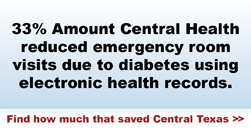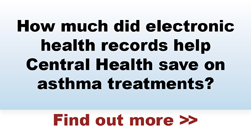Editor’s Note: How many times have you gone to a doctor and filled out pages and pages of information, only to later check the same boxes for another doctor—one who might even be just down the hall from the first one? Or answered the same question from the same nurse every time you come into the office? Or perhaps forgotten to mention an allergy or reaction?
There is little doubt that the details of our medical histories are critical to our individual health. So for the most part we abide the hassle, wondering why our doctors have state-of-the-art X-ray machines but still write illegible prescriptions using a ballpoint pen.
Over the past several decades, however, technology has spurred tremendous advances in data capture and collection and analysis of healthcare records.
Central Health, which creates access to healthcare for uninsured residents of Travis County, is a pioneer in the application of these advances. In this article, Central Health President and CEO Patricia Young Brown discusses how Central Health and its affiliate CommUnityCare , a 20-site federally qualified health center system, are using electronic health records and health information exchanges to improve the health of their patients, increase the efficiency of their providers, and address health issues across Central Texas.
A tool for health
In many ways, medicine is a big puzzle. One person—and one community—can generate a million pieces of information: medical histories, labs, medications, conditions, environments, allergies, and other data. The challenge for medical providers and medical systems is to fit together all those pieces to understand problems and identify treatments that will improve health.
The emergence of electronic health records (EHRs) and health information exchanges (HIEs) are technological game-changers for health. These tools allow healthcare providers to look at the health of our patients and our community as a complete 10,000-piece puzzle versus a hodgepodge impressionist blur with many missing pieces.
Central Health’s affiliate, CommUnityCare, with its 20 federally qualified health centers, was an early adopter of EHRs. CommUnityCare uses this tool to track medical histories, office visits, lab work, X-rays, diagnoses, allergies, medications, and more. All that information is connected together and shared via a health information exchange (HIE) in Central Texas called ICare.
These technology advancements are improving Central Texas health care in five important ways:
1) Patients can manage their own healthcare and receive better care.
EHRs are computer files that contain prescriptions, medical conditions, immunizations, doctor visits, X-rays, lab work, and other data that follow a patient throughout a healthcare system. The obvious benefits are that a patient does not need to fill out multiple forms repeatedly, their personal data can be accessed easily, and doctors’ visits can be much more efficient for patients and providers.
Electronic storage of this data in one central place also makes it much easier for patients to access information on their own. Patients can easily get electronic copies or printouts of their health information. Over time, patients may even be able to directly input personal information, share it, view their records, make appointments, and send encrypted e-mail to physicians, among other possibilities.
“We need to be in control of our own health, not just rely on the staff. Access to information helps us manage our own care,” said patient Barbara Shirley. “Knowledge is power. It’s cliché, but if you know your blood sugar is not where it should be then you, [the patient,] know what you need to do to get it where it should be.”
This data can also help avoid mistakes. An emergency room (ER) doctor can access your allergy information and avoid giving you a medication that could cause a fatal reaction. The pharmacy can also access this information and raise a red flag.
2) Physicians have improved tools to help them better assess patients on both the individual and group levels.
EHRs are improving the efficiency and effectiveness of doctors, as well. Dr Le-Wai Thant, a pediatrician at the CommUnityCare South Austin health center, has used EHRs for five years, and has recently made the shift to an entirely paperless system.
EHRs are giving Dr. Thant more complete and up-to-date medical records. “If a patient has gone to the ER and then comes back to see me, I now can access their electronic record from the ER, understand all the pieces, and provide more complete patient care.” This is much easier than trying to pull all the pieces from the patient, who may not remember or understand everything that occurred in the ER.
EHRs also allow physicians to look at their own data and patients’ data from a more global perspective to improve quality of care. Because EHRs capture information longitudinally, they produce data that is much more robust than a paper chart and make it much easier to search, sort, and connect the dots.
For example, during flu season, Dr. Thant uses electronic data to proactively identify all her patients with asthma and encourages them to get the flu shot. She also uses collective data from her patients to inform disease-management meetings with doctors from other clinics. These meetings allow doctors to identify disease trends and proactively connect patients with new disease-management tools.
3) Improved health technology improves health.
CommUnityCare and other primary care safety-net providers, including Lone Star Circle of Care, People’s CommUnity Clinic, El Buen Samaritano, and Seton Community Health Centers, have pooled data with all the hospitals in the Central Texas region to accumulate more than one million patient records in the ICare system, a health information exchange established by the Integrated Care Collaboration (ICC). Pooling this data allows us to see broad health trends as well as proactively manage individual patient health.
For example, this collaboration is expanding a program that uses the information in EHRs to prevent avoidable emergency room visits and inpatient hospitalizations related to asthma. Currently, if a patient, insured or otherwise, visits a local ER for an avoidable asthma visit, the patient is flagged in ICare, and data is shared with the asthma program personnel. A respiratory therapist then contacts the patient to provide education and case management, including home visits to identify possible triggers of asthmatic episodes.
In its first year, the program reduced the incidence of asthma-related inpatient visits by 95 percent, reduced asthma-related emergency room visits by 40 percent, and resulted in a return on investment of $5.50 for every $1 invested in the program.
EHRs have also greatly improved diabetes management. EHR data allowed CommUnityCare to more effectively identify and treat patients with diabetes through a home-based diabetes education program. Using lab histories and records of blood-sugar levels and treatment effects, providers were able to identify patients who could benefit from direct connections with dieticians, educational materials, and tools such as glucometers.
In addition to improved clinical outcomes, the program demonstrated a 33 percent decrease in emergency room visits related to diabetes, a corresponding 75 percent decrease in inpatient visits, and an overall 61 percent decrease in all types of care. In today’s dollars, the decrease in medical expenditures was $428,028.00. For every dollar spent, $2.85 is saved through cost avoidance and care coordination, not to mention the value of increased productivity in the workforce.
4) Electronic records improve the efficiency of healthcare facilities.
CommUnityCare health centers use EHR data to combat one of their patients’ chief complaints by minimizing patient wait times. The goal is to have patients in and out of the health center within 90 minutes. EHRs capture time data, which allows health centers to assess wait and processing times. The data allows them to identify training needs among staff, for example, to expedite a procedure or identify an alternative best practice to avoid wasted time.
This data is also used to better understand patient needs and connect patients with the right providers. Based on anecdotal evidence, CommUnityCare providers suspected that many uninsured and underinsured patients wound up in the emergency room because they could not afford to miss work to visit a clinic during normal business hours. Hard data gleaned from EHRs validated that this dilemma was real for many of their patients, which made it much easier for providers to implement changes in our operating hours and our walk-in-clinic capacity. CommUnityCare then used follow-up data to assess the value and document the cost-savings of this change to the community.
5) More information allows us to better manage health on a community-wide basis.
Health information technology is also facilitating collaboration between providers and community entities that results in a number of benefits. First, the HIE makes it possible for healthcare providers to monitor and improve a patient’s continuity of care across the entire healthcare spectrum.
The uninsured and underinsured tend to seek care wherever they can find it. They go to primary-care doctors, specialists when needed, and then hospitals when acutely ill. All too often, the emergency room is their only point of entry to care. In this scenario, there is no one tracking care or connecting the dots. Using an HIE helps us connect disparate pieces of data to create a “virtual safety net.” While we cannot put every provider together in a room physically, we can virtually, which allows us to create information flow for more seamless delivery of care.
The ICC efforts have also extended benefits throughout the community. For example, the data gathered through the asthma pilot study has spurred follow-up studies and the extension of services by Seton hospitals and other healthcare providers.
In addition, several years ago the ICC analyzed emergency room data and found that Central Texas had 900 frequent users of the ER (users who visited six or more times in three months) for the time period studied. Those 900 patients had 2,123 preventable visits to the ER in 2007. Those preventable visits made up 18 percent of the 11,600 total visits to Central Texas ERs and cost more than $2 million. Hospitals, the government, and eventually taxpayers bear the costs of those visits. With this data in hand, providers were able to reach out to a small subset of those 900, a select group of very high-utilizing individuals, to provide case management and connect them to the appropriate social and health services.
Putting the puzzle together
The advancements of EHRs and HIEs have allowed healthcare providers to see and tell the story of what is going on with the patient and put all those puzzle pieces together.
Getting records online and being able to share and exchange health information digitally is not a matter of upgrading to a cool new “app” or creating prettier pictures of your blood pressure levels. It is a long-term journey and an investment that will improve our ability to provide personalized, high-quality care; support a healthier population; and help us achieve our vision of helping Central Texas become a model healthy community.
It’s important to remember that technology is a tool and that our progress all depends on how well our tools are utilized. We can create a wealth of information, but if we are not deliberate, that information never converts to knowledge. Health information technology can help us ensure the right kind of care at the right the place and at the right time.
Learn More

|








